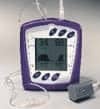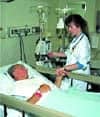Innovative Protocols

Respiratory care practitioners at the University of Washington Medical Center in Seattle assess each ventilator patient every day for extubation potential. Upon detecting that potential, they recommend immediate removal of the vent line. No waiting, no weaning.
Extubation potential is a status abundantly detailed in a protocol developed by the medical center’s Respiratory Care Services Department and now in use throughout the 450-bed hospital, explains John Dobrozsi, RRT, RCP, adult clinical specialist in the department.
“We don’t wean slowly over 5 or 6 days like other facilities,” he says. “When patients require ventilatory support, we support them completely. On the other hand, when they’re ready to be extubated, they’re extubated—there is very little intermediate ground.”
The extubation protocol has been credited with improvements in quality of care as well as delivering some cost savings, both of which are considered essential in an academic institution like the University of Washington, where 111,612 patient days were recorded in fiscal 2002.
“As a result of the protocol, average length of stay in the ICUs has become shorter,” says Dobrozsi. “It’s also decreasing ventilator hours, which reduces the patient’s risk for ventilator-associated pneumonia and other complications associated with mechanical ventilation.”
Dobrozsi says that the protocol continues to undergo refinement as outcomes data accumulate and hint at ways it can be modified for greater effect, but innovative development work of this sort typifies life in this particular facility.
“Our respiratory care staff is very patient-focused and we always want to do what’s best for the patient,” says Dobrozsi. “So, we’re thinkers and doers. We don’t sit back and accept the status quo. We’re continually looking to change things for the better and improve our ability to care for patients.”
CHALLENGING CASES ABOUND
Filling Respiratory Care Services’ ranks are approximately 45 licensed practitioners, with seven of every 10 focused on critical care activities during any given shift. In large part, that is because the University of Washington Medical Center is the Northwest’s premier provider for transplants—heart and lung mainly, but also kidney, pancreas, liver, and bone (last year the facility ranked 11th in the US News and World Report annual survey of America’s finest hospitals).
“We’re very involved with those transplants, beginning in the operating room and carrying through the entire ventilator course,” says Ken Myrabo, RRT, MEd, manager of Respiratory Care Services.
The majority of Respiratory Care Services’ activities are conducted within the confines of the inpatient hospital building. The remainder are provided at a clinic site elsewhere on campus (last year, the facility logged 333,046 clinic visits), and some of those are offered in conjunction with entities not owned by the university, such as the Seattle Cancer Care Alliance.
An estimated 45% of patients utilizing the University of Washington Medical Center come from Seattle and environs. The remainder live in Idaho, Montana, Wyoming, and Alaska.
“Thanks to our five-state referral base, we’re the nation’s largest hospital of its kind this far north and west,” says Myrabo. “When you pull in patients from such a geographically diverse market, you’re bound to encounter types of cases found nowhere else in the country, cases that are very unusual and very challenging.”

STATE-OF-THE-ART EQUIPMENT
In addition to clinical work, respiratory care practitioners at the university’s medical center also participate extensively in research activities. These include an Adult Respiratory Distress Syndrome (ARDS)-Net study of lung protective ventilation strategies and the National Emphysema Therapy Trial funded by Medicare and the National Institutes of Health to assess the effectiveness of lung volume-reduction surgery.
“We also have under way a neonatal nitric oxide study, which we expect will yield some very positive results,” Myrabo says. “Unfortunately, research isn’t cheap, and a grant doesn’t always cover the costs. We usually end up having to underwrite a lot of the research ourselves. But, when you get right down to it, the costs are nothing compared to what we gain in terms of insights to providing better care.”
Dobrozsi agrees, pointing to the ARDS-Net study as one example. “The lung protective ventilation strategies that seemed quite radical and provocative when the study started have since then found their way into our standard of care,” he says.
All of the department’s research endeavors are abetted by an impressive array of state-of-the-art equipment, purchased new. Responsibility for identifying products for acquisition consideration belongs to Myrabo, Dobrozsi, two (soon to be three) other clinical specialists, and the department’s medical director.
“Before we make a decision to buy, we let the staff evaluate the equipment,” says Dobrozsi. “We rely heavily on their input as to how effectively they see the equipment fitting into their daily jobs.”
EVIDENCE-BASED PRACTICE
Currently, a top priority for Respiratory Care Services is the promotion of evidence-based practice in every corner of the medical center. One place where that will not be necessary is the Northwest Assisted Breathing Center, located in the outpatient clinic area. The center—operated by Respiratory Care Services’ Medical Director Josh Benditt, MD, with Louis Boitano, RRT, RPFT, MS, and neurologic nurse-practitioner Nancy Schuman, RN—is a rich vein of evidence-based practice built on a solid foundation of research.
“We’re currently investigating how end-tidal CO2 compares with blood-gas for monitoring the patients we see here in the center,” says Benditt, explaining that all of them suffer from neuromuscular problems such as muscular dystrophy, amyotrophic lateral sclerosis, myasthenia gravis, and the effects of spinal cord injury. “We’re also seeking a grant to examine how noninvasive ventilation impacts quality of life. Of the nearly 200 patients at the center, a good portion are right now on noninvasive ventilation. Our study will look at the quality of life of people who have 24-hour noninvasive ventilation versus those with a traditional tracheostomy. We have anecdotal evidence to suggest that patients find their quality of life is better with noninvasive. Now we need to concretely demonstrate that.”
Northwest Assisted Breathing Center patients are seen by Benditt and his colleagues twice a week and in conjunction with the rehabilitation department’s muscular dystrophy clinic.
“When muscular dystrophy patients come through with any breathing problems, they’re screened for tidal capacity, maximal inspiratory pressure, and so forth,” says Benditt. “If they show decrements in those, then they’re referred to me and my team. We’re committed to treating them with noninvasive ventilation as far as possible. But to qualify for 24-hour noninvasive ventilation, the one thing they must have is good bulbar muscle function—their throat and mouth muscles must be able to tolerate the mouthpiece and nasal mask.”
The department’s plans for the future include increased attention to staff development, both professionally and personally.
“We’re going to be making sure that our staff are recognized and rewarded for their efforts to grow,” says Dobrozsi. “According to our latest survey, the staff has indicated that the greatest form of recognition they can be given comes first and foremost from their patients and then from their peers and colleagues in the hospital. We feel the best way to foster recognition on both those levels is to give our staff the ability to do their jobs well so they can provide excellent patient care. All else flows from that.”
Rich Smith is a contributing writer for RT Magazine.
References
1. Orem J, Kubin L. Respiratory physiology: central neural control. In: Kryger MH, Roth T, Dement WC, eds. Principles and Practice of Sleep Medicine. 3rd ed. Philadelphia: WB Saunders; 2000:212-221.
2. Krieger J. Respiratory physiology: breathing in normal subjects. In: Kryger MH, Roth T, Dement WC, eds. Principles and Practice of Sleep Medicine. 3rd ed. Philadelphia: WB Saunders; 2000:232-241.
3. Grunstein R, Sullivan C. Neural control of respiration during sleep. In: Thorpy MJ, ed. Handbook of Sleep Disorders. New York: Marcel Dekker; 1990:77-102.









